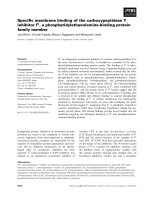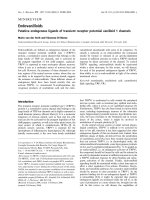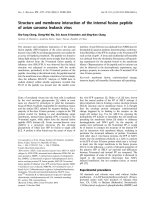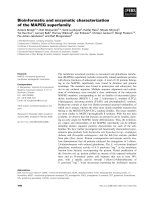Báo cáo khoa học: "Techniques for controlled synthesis of the Douglas-fir - Laccaria laccata ectomycorrhizal symbiosis" docx
Bạn đang xem bản rút gọn của tài liệu. Xem và tải ngay bản đầy đủ của tài liệu tại đây (1.15 MB, 10 trang )
Technical
note
Techniques
for
controlled
synthesis
of
the
Douglas-fir -
Laccaria
laccata
ectomycorrhizal
symbiosis
R Duponnois
J
Garbaye
1
BIOCEM,
Laboratoire
de
Technologie
des
Semences,
avenue
du
Bois
l’Abbé,
49070
Beaucouzé;
2
INRA,
Centre
de
Recherches
Forestières
de
Nancy,
Champenoux,
54280
Seichamps,
France
(Received
7
February
1991;
accepted
16
August
1991)
Summary —
Laccaria
laccata
(Scop
ex
Fr)
Cke
is
an
ectomycorrhizal
basidiomycete
which
is
very
efficient
for
the
controlled
mycorrhization
of
Douglas-fir
(Pseudotsuga
taxifolia
Poir
Britt).
Studying
the
biology
of
this
symbiosis
led
to
the
development
of
a
number
of
experimental
techniques
for
aseptic
and
non-aseptic
synthesis.
This
paper
describes
seed
treatements,
fungal
inoculum
prepara-
tion,
substrates,
nutrient
solutions,
aseptic
experimental
systems
(test
tubes
and
Petri
dishes)
and
non-aseptic
systems
(pot
experiments
in
the
glasshouse)
and
bare-root
nursery
techniques.
The
specificity
of
each
technique
is
discussed
according
to
the
experimental
purpose.
ectomycorrhizas
/
aseptic
synthesis
/
non-aseptic
synthesis
/
Pseudotsuga
taxifolia
/
Lacca-
ria
laccata
Résumé —
Techniques
d’étude
de
la
symbiose
ectomycorhizlenne
entre
le
douglas
et
Lacar-
ria
laccata.
Laccaria
laccata
(Scop
ex
Fr)
Cke
est
un
champignon
basidiomycète
ectomycorhizien
très
efficace
pour
la
mycorhization
contrôlée
du
douglas
(Pseudotsuga
taxifolia
Por
Britt).
L’étude
de
la
biologie
de
cette
symbiose
a
conduit
à
la
mise
au
point
d’un
certain
nombre
de
techniques
expéri-
mentales
pour
réaliser
sa
synthèse
en
conditions
aseptiques
ou
non
aseptiques.
Cette
note
décrit
le
traitement
des
graines,
la
préparation
de
l’inoculum
fongique,
les
solutions
nutritives,
les
substrats,
les
systèmes
expérimentaux
aseptiques
(tubes
à
essais
[fig 1]
et
boîtes
de
Petri
[fig 2])
et
non
asep-
tiques
(expériences
en
pots
en
serre
[figs
3, 4, 5,
6]
et
techniques
de
pépinière
à
racines
nues).
Les
techniques
aseptiques
in
vitro
permettent
d’étudier
l’effet
de
divers
facteurs
expérimentaux
sur
la
dy-
namique
de
l’infection
ectomycorhizienne,
mais
pas
l’effet
de
la
mycorhization
sur
la
croissance
de
la
plante.
Cet
effet
se
manifeste
en
serre
et
en
pépinière.
Certains
des
dispositifs
proposés
pour
les
expériences
en
serre
permettent
l’observation
directe
et
non
destructive
du
système
racinaire.
ectomycorhizes
/
synthèses
axéniques
/
synthèses
non-axéniques
/
Pseudotsuga
taxifolia
/
Laccaria
laccata
*
Present
address:
As
for
J
Garbaye
(2)
INTRODUCTION
Douglas-fir
is
presently
the
dominant
for-
est
tree
species
used
for
reforestation
in
France.
Field
experiments
have
shown
that
the
ectomycorrhizal
fungus
Laccaria
laccata,
when
inoculated
to
planting
stocks
in
the
nursery,
stimulates
the
early
growth
of
outplanted
Douglas
fir
(Molina,
1980;
Le
Tacon
et al,
1983, 1985, 1988;
Mortier
et
al, 1988).
As
practical
applications
of
these
re-
sults
are
developing,
different
aspects
of
the
association
are
being
investigated
by
INRA
in
order
to
improve
performance
and
to
select
more
efficient
fungal
strains.
The
physiology
of
the
symbiosis
is
studied
in
aseptic
in
vitro
systems,
and
experiments
in
glasshouse
and
nursery
conditions
are
carried
out
in
order
to
study
how
mycorrhi-
zal
establishment
is
affected
by
environ-
mental
factors
and
compare
the
behavior
of
inoculated
and
non-inoculated
seedlings
submitted
to
different
treatments,
in
condi-
tions
close
to
practice.
The
aim
of
this
note
is
to
help
readers
working
on
similar
symbiotic
systems
choose
the
technic
the
best
adapted
to
their
own
experimental
purpose.
PRODUCTION
OF
FUNGAL
INOCULUM
Maintenance
of
the
fungal
strain
The
ectomycorrhizal
basidiomycete
Lac-
caria
laccata
(Scop
ex
Fr)
Cke
isolate
S-
238
from
USDA
(Corvallis,
OR)
is
main-
tained
in
Petri
dishes
(6
cm
diameter)
on
modified
Pachlewski
agar
medium
(Pach-
lewski
and
Pachlewska,
1974).
The
com-
position
is
for
1
liter
as
follows:
di-
ammonium
tartrate:
0.5
g;
KH
2
PO
4:
0.5
g;
MgSO
4,
7H
2
O:
0.5
g;
maltose:
5.0
g;
glu-
cose:
20
g;
thiamine:
1
μg:
Fe
EDTA:
0.6
mg;
Mo:
0.03
mg;
B:
0.13
mg;
Mn:
0.5
mg;
Cu:
0.06
mg;
Zn:
0.23
mg;
Agar:
20
g.
Mi-
cronutrients
(Fe,
Mo,
B,
Mn,
Cu
and
Zn)
are
applied
together
as
0.1
ml
of
a
concen-
trated
commercial
solution:
Kanieltra
(CO-
FAZ,
BP
198-08,
Paris,
France).
Cultures
are
kept
at
25 °C
in
a
dark
incubation
chamber.
When
growing,
the
mycelium
de-
velops
a
bright
lilac
color,
which
reaches
maximal
intensity
after
1
month.
Cultures
are
transferred
into
fresh
medium
after
2
months,
when
the
colonies
have
a
diam-
eter
of
about
4
cm.
Liquid
inoculum
L
laccata
is
grown
in
1-liter
Erlenmeyer
flasks
stoppered
with
cotton
wool
and
con-
taining
500
ml
of
liquid
modified
Pachlew-
ski
medium.
The
flasks
are
inoculated
with
8
agar
disks
(6
mm
diameter)
cut
from
the
margin
of
a
culture
on
modified
Pachlewski
agar
medium.
After
2
weeks,
the
mycelium
develops
a
lilac
color
which
permits
detec-
tion
of
contaminants.
This
typical
colour
does
not
develop
as
well
in
other
media
such
as
Melin
(Melin,
1936),
malt
extract
or
brewery
wort.
Flasks
are
kept
in
the
dark
at
25 °C
on
an
orbital
shaker
for
1
month.
The
mycelium
is
then
washed
in
tap
water
in
order
to
remove
residual
nutri-
ents,
homogenized
in
a
Waring
blender
for
≈
10
s
and
resuspended
in
distilled
water.
This
kind
of
fungal
inoculum
is
quantified
by
measuring
the
fungal
dry
weight
per
ml
or
by
counting
living
propagules
(determi-
nation
of
colony
forming
units
by
spreading
1
ml
of
suspension
on
a
6-cm
Petri
dish
with
nutrient
agar).
The
viability
of
the
sus-
pension
does
not
decrease
before
4
weeks
at
4 °C.
Vermiculite-peat
inoculum
(adapted
from
Marx
and
Bryan, 1975)
Glass
jars
(1.6
I)
containing
1.3
I
expanded
vermiculite-sphagnum
peat
mixture
(4:5-
1:5,
v:v,
pH
=
5.5)
are
autoclaved
(120 °C,
20
min).
Another
ratio
of
vermiculite-peat
can
be used
(2:3-1:3).
The
peat
can
re-
lease
some
substances
which
are
toxic
for
fungal
growth.
For
this
reason,
the
first
ra-
tio
mixture
is
preferred.
Then
the
mixture
is
moistened
to
field
capacity
with
600
ml
modified
liquid
Pachlewski
medium.
The
jars
are
stoppered
with
lids
with
a
1-cm
di-
ameter
hole.
This
hole
is
fitted
with
a
4-cm
long
tube
filled
with
cotton
wool.
The
jars
are
then
autoclaved
a
second
time
(120 °C
for
20
min).
After
cooling,
8
mycelial
plugs
are
laid
on
top
of
the
substrate.
Mycelium
grows
down
into
the
substrate,
which
is
completely
colonized
after
6
weeks
at
25 °C.
For
faster
growth,
jars
can
be
filled
with
a
smaller
quantity
of
substrate
and
shaken
after
mycelia
have
colonized
a
few
centimeters:
in
this
manner,
mycelium
is
evenly
distributed
throughout
the
substrate
and
incubation
time
is
shortened.
This
in-
oculum
can
be
stored
at
4
°C
for
up
to
6
months.
Alginate
beads
inoculum
The
process
of
including
fungal
mycelium
in
polymeric
gels
(especially
calcium
algi-
nate)
has
been
previously
described
(Dom-
mergues
et al,
1979;
Le
Tacon
et al,
1983,
1985).
The
inoculum
prepared
in
this
man-
ner
is
more
efficient
than
the
classical
ver-
miculite-peat
inoculum
(Mortier
et
al,
1988)
because
the
mycelium
is
protected
in
the
gel
from
physical
stresses
(eg
water
stress)
and
from
competitor
microorgan-
isms.
With
this
technique,
it
is
possible
to
accurately
control
the
weight
of
mycelium
or
the
number
of
living
propagules
con-
tained
in
the
inoculum.
Different
attempts
have
been
made
to
measure
the
quantity
of
mycelium
in
the
vermiculite-peat
inocu-
lum:
ergosterol
assay
(Martin
et al,
1990);
chitin
assay
(Vignon
et al,
1986),
but
none
of
them
gave
reliable
results
(Mortier
et
al,
1988)
because
of
the
peat
which
interferes
with
colorimetric
measurements.
A
mycelial
suspension,
obtained
as
pre-
viously
described,
is
mixed
(1:1,
v:v)
with
distilled
water
containing
20
g
l
-1
sodium
alginate
and
50
g
l
-1
autoclaved
dry
pow-
dered
sphagnum
peat.
When
aseptic
inoc-
ulum
is
needed,
the
alginate
solution
and
the
peat
should
be
autoclaved
separately.
The
final
solution
is
pumped
throught
a
pipe
with
2-mm
holes.
The
drops
fall
into
a
100
g
l
-1
CaCl
2
solution
and
form
beads
of
reticulated
calcium
alginate
gel
(Mauperin
et
al,
1987).
The
beads
are
kept
in
CaCl
2
for
24
h
at
room
temperature
in
order
to
ensure
complete
reticulation.
They
are
then
washed
with
tap
water
to
remove
NaCl
and
CaCl
2
and
stored
in
air-tight
con-
tainers
at
4
°C
in
order
to
prevent
drying.
This
type
of
inoculum
can
be
kept
up
to
9
months
in
these
conditions.
The
beads
are
prepared
with
1-2
g
mycelium
(dry
weight)
per
I
of
final
solution
(Mortier
et
al,
1988).
ASEPTIC
MYCORRHIZAL
SYNTHESIS
As
for
all
the
techniques
described
below,
the
seeds
of
Douglas-fir
(Pseudotsuga
tax-
ifolia
(Poir)
Britt
(syn
P
douglasii
(Lindl)
Carr,
syn
P
menziesii
(Mirb)
Franco,
syn
P mucronata
(Raf)
Sudw)
are
from
prove-
nance
zone
412
(Snoqualmie
Falls,
Wash-
ington
State,
USA).
They
are
supplied
by
Vilmorin
(La
Ménitré,
49250
Beaufort-en-
Vallée,
France).
All
the
aseptic
experimental
systems
presented
here
are
designed
for
studying
the
dynamics
of
symbiosis
establishment
between
the
plant
and
the
fungus.
Howev-
er,
due
to
the
limited
volume
of
the
vessel
containing
the
roots,
they
are
not
suitable
for
the
expression
of
a
growth
effect
on
the
plant.
Root
exudates
provide
the
carbon
needed
for
the
fungal
growth
(Harley
and
Smith,
1983).
The
release
of
these
sub-
stances
is
linked
to
photosynthesis
(Hacs-
kalylo,
1973).
Therefore,
in
order
to
obtain
normal
photosynthesis,
the
aerial
part
of
the
plant
is
kept
under
non-axenic
condi-
tions
outside the
tube
or
the
Petri
dish
and
the
roots
are
kept
inside
the
culture
vessel
under
axenic
conditions.
If
the
aerial
part
of
the
plant
were
kept
inside,
parameters
affecting
gas
exchange
(temperature,
CO
2,
humidity)
would
be
altered.
Cultures
are
set
in
a
climate-controlled
growth
chamber
with
23 °C
day,
17 °C
night,
16
h
photoperiod
with
240
μE.m
-2.s-1
(Mazda
MAIH
400
lamps),
80%
relative
humidity.
The
seeds
are
surface-sterilized
in
30%
H2O2
for
90
min,
washed
for
4
h
in
sterile
water,
and
plated
on
glucose
(1
g.l
-1
)
agar
in
order
to
detect
contamination.
Contami-
nated
seeds
are
discarded
and
germinants
are
used
when
taproots
are
1-2
cm
long.
Test-tube
system
(fig 1)
The
2
components
of
the
system
(fungus,
plant)
are
aseptically
confronted
in
glass
test-tubes
(3
x
15
cm)
filled
with
auto-
claved
(120 °C,
20
min)
peat-vermiculite
(1:1,
v:v)
moistened
to
field
capacity
with
modified
Shemakanova
mineral
nutrient
solution
(Shemakanova,
1962):
MgSO
4,
7H
2
O:
150
mg;
(NH
4)2
HPO
4:
125
mg;
(NH
4)2
SO
4:
125
mg;
CaCl
2,
2H
2
O:
50
mg;
KCI:
108
mg;
Kanieltra:
0.1
ml;
distilled
water:
1
liter).
Fungal
inoculation
can
be
achieved
with
peat-vermiculite
inoculum
(either
mixed
throughout
the
substrate
(1:10,
v:v)
or
laid
on
top
of
the
tube
(1-2
cm),
alginate
beads
(5
beads
laid
on
top
of
the
tube)
or
mycelium
suspension
(inject-
ed
with
a
syringe
or
deposited
with
a
pi-
pette).
The
tubes
are
covered
with
alumin-
ium
foil
and
the
rootlet
of
one
aseptically
germinated
seed
is
introduced
through
a
hole
in
the
foil
and
sealed
with
autoclaved
coachwork
putty
(Terosta
2,
Teroson
SA,
Asnières,
France).
The
roots
are
main-
tained
in
axenic
conditions,
while
the
aerial
part
of
the
plant
develops
outside
the
tube.
After
1
month
of
culture,
the
plant
is
re-
moved
from
the
tube
and
roots
are
ob-
served
with
a
stereomicroscope.
Each
seedling
bears =
100
short
roots,
30-100%
of
them
being
mycorrhizal
with
Laccaria
laccata,
depending
on
variable
factors.
Petri
dish
systems
(fig 2)
Circular
(diameter
=
12
cm)
or
square
(12
x
12
cm)
Petri
dishes
can
be
used.
They
are
filled
to
the
lid
with
substrate:
auto-
claved
soil,
autoclaved
silica
sand
(0.5-1.2
mm)
washed
with
6
N
HCl
and
rinsed
with
tap
water
or
vermiculite-peat
mixture
(1:1,
v:v).
Soil
is
moistened
to
field
capacity
with
distilled
water
and
the
2
other
substrates
with
modified
Shemakanova
nutrient
solu-
tion.
The
rootlets
or
2
or
3
aseptically
germi-
nated
seeds
are
introduced
through
holes
2-3
cm
apart
in
the
side
wall of
the
dish
and
sealed
with
autoclaved
coachwork
put-
ty.
The
lid
is
sealed
with
plastic
adhesive
tape.
The
dishes
are
set
upside
down
at
a
45°
angle
in
the
grown
chamber,
so
that
roots
grow
down
against
the
lid.
As
in
test
tubes,
mycorrhiza
can
be
obtained
after
1
month
of
culture,
with
the
same
number
of
short
roots
per
plant
and
the
same
mycor-
rhizal
infection
rate.
Compared
with
the
test
tubes,
this
Petri
dish
system
enables
observation
of
the
roots
through
the
lid
with
a
stereomicro-
scope
(monitoring
root
and
fungal
growth,
counting
mycorrhizas,
etc).
Dishes
can
also
be
opened
under
sterile
atmosphere
for
root
sampling
or
addition
of
various
ino-
cula
or
chemicals.
NON-ASEPTIC
SYNTHESIS
IN
THE
GLASSHOUSE
Before
sowing,
Douglas-fir
seeds
are
ei-
ther
pretreated
in
moist
sphagnum
peat
for
8
weeks
at
4
°C
or
surface
sterilized
in
30%
H2O2
for
90
min,
washed
for
4
h
in
sterile
water
and
kept
overnight
in
water
at
4 °C.
The
germination
rate
is
better
with
the
first
technique
but
the
risks
of
damping
off
due
to
Rhizoctonia
spp,
Fusarium
spp
or
other
pathogens
is
higher.
The
method
using
H2O2
eliminates
the
pathogens
and
suppresses
seed
dormancy.
The
seedlings
can
be
grown
on
soil
(disinfected
or
not
by
steam
or
methyl
bro-
mide
fumigation)
or
non-disinfected
ver-
miculite-peat
mixture
(1:1,
v:v).
Several
kinds
of
container
can
be used
for
growing
Douglas
fir
seedlings
in
the
glasshouse,
depending
on
the
aim
of
the
experiment.
Hiko
containers
(fig
3)
The
black
high-density
cast
polyethene
Hiko
containers
are
manufactured
in
Swe-
den.
They
are
trays
containing
24
or
40
cells
of
150
or
93
cm
3,
respectively.
They
are
easy
to
fill
and
occupy
the
room
in
the
glasshouse
very
efficiently.
However,
holes
at
the
bottom
are
wide
and
flowing
substrates
such
as
sandy
soils
have
to
be
maintained
by
peat
or
glass-wool
plugs.
Another
drawback
is
that
Hiko
containers
cannot
be
opened.
One
seedling
is
grown
in
each
cell.
Transparent
boxes
(fig
4)
These
are
20
x
7.5
x
2.2
cm
clear
polysty-
rene
boxes
(Ref
LH
275.22,
Établisse-
ments
Caubère,
Paris,
France).
One
ex-
tremity
is
cut
open
and
three
1-cm
holes
are
bored
in
the
other
end
in
order
to
en-
sure
drainage.
Boxes
are
wrapped
with
black
polythene
film
to
prevent
green
algae
proliferation,
and
maintained
inclined
at
45°
in
order
to
force
root
growth
against
the
lower
wall.
Two
or
3
seedlings
are
grown
per
box.
This
type
of
container
presents
the
same
advantages
as
the
Petri
dish
system
previously
described
for
asep-
tic
cultures:
non-destructive
observation
of
roots,
sampling
and
various
manipulations.
Rootrainers
(fig 5)
These
thermoformed
PVC
containers
(Spencer-Lemaire
Industries
Ltd,
Edmon-
ton,
Alberta,
Canada)
are
like
books
form-
ing
cells
when
closed.
The
"books"
are
packed
in
trays.
Different
capacities
are
available:
115,
175,
250 and
1
300
ml
per
cell.
Root
and
mycorrhiza
development
can
be
monitored
any
time
by
opening
the
"books".
Rootrainers
present
the
same
drawback
as
Hiko
containers
when
filled
with
flowing
substrates.
"M"
containers
(fig
6)
(Riedacker,
1978)
The
"M"
containers
(Thermoflan,
Molières-
Cavaillac,
Le
Vigan,
France)
are
made
of
2
folded
PVC
parts,
fitted
into
each
other,
which
can
be
separated
any
time
for
non-
destructive
root
observations.
They
are
completely
opened
at
the
bottom
and
can
only
be
filled
with
pure
peat
without
plug-
ging.
Their
capacity
is
400
ml.
Whatever
the
container
type,
2
or
3
seeds
are
sown
per
cell
in
order
to
ensure
at
least
1
germinating
seed.
When
seed-
lings
are
5
weeks
old,
they
are
thinned
to
1
per
individual
container.
When
soil
is
used
as
a
substrate,
seedlings
are
wa-
tered
daily
with
deionized
water.
When
the
vermiculite-peat
substrate
is
used,
the
fol-
lowing
nutrient
solution
is
applied
in
ex-
cess
twice
a
week
in
addition
to
daily
wa-
tering
with
deionized
water:
for
1
liter,
KNO
3:
80
mg;
Ca(NO
3)2,
4H
2
O:
19
mg;
NaH
2
PO
4,
H2
O:
9
mg;
MgSO
4,
7H
2
O:
74
mg;
Kanieltra:
10
μl.
The
composition
of
this
solution
has
been
experimentally
de-
termined
in
order
to
provide
optimal
mycor-
rhizal
establishment.
Concentrations
of
macroelements
in
mg
l
-1
are:
P:
1.8;
N:
33.5;
K:
31.0;
Ca:
32.0;
Mg:
7.2.
Fungal
inoculation
can
be
performed
ei-
ther
by
mixing
vermiculite-peat
or
alginate
inoculum
throughout
the
substrate
before
filling
the containers
or
by
opening
them
when
roots
are
well
developed
and
spread-
ing
any
of
the
3
previously
described
inoc-
ulum
types
on
the
root
system.
In
all
these
glasshouse
experiments,
mycorrhizal
infection
begins
8
weeks
after
sowing.
After
one
growing
season
(5-6
months),
mycorrhizal
rate
can
be
close
to
100%
for
seedlings
≈ 10-12
cm
tall
in
the
smallest
containers.
LARGE
SCALE
SYNTHESIS
IN
BARE-ROOT
NURSERY
CONDITIONS
The
seeds
are
pretreated
in
moist
sphag-
num
peat
for
8
weeks
at
4
°C
before
sow-
ing.
The
nursery
soil,
freshly
tilled
and
at
10 °C
minimum,
is
fumigated
in
spring
with
cold
methyl
bromide
(75
g
per
m2,
soil
cov-
ered
with
clear
polythene
film
for
4
days).
The
film
is
removed
3
weeks
before
inocu-
lating
and
sowing.
Toxicity
is
eliminated
during
this
time.
This
fumigation
destroys
all
the
microorganisms
which
can
compete
with
the
inoculated
fungus
(Le
Tacon
et
al,
1983).
The
nursery
beds
are
divided
into
0.5-
m2
plots
separated
from
each
other
by
50
cm
uninoculated
and
unsown
zones.
The
fungal
inoculum
is
broadcast
and
incorpo-
rated
into
the
10
cm
topsoil
at
the
dose
of
2
I
per
m2
for
peat—vermiculite
inoculum
(in
this
case,
it it
impossible
to
determine
the
quantity
of
mycelium)
or
1
liter
per
m2
for
alginate
beads
(2
g
mycelium
(dry
weight)
per
m2
).
The
culture
is
managed
using
routine
nursery
practices
except
that
fertilization
is
suppressed
or
considerably
reduced,
and
that
systemic
fungicides
are
banned.
Under
these
conditions,
mycorrhizal
rate
with
Laccaria
laccata
ranges
from
60-
80%
at
the
end
of
summer,
with
seedlings
5-20
cm
in
height
depending
on
the
nur-
sery.
Under
these
nursery
conditions,
the
effect
of
Laccaria
laccata
inoculation
is
dramatic:
the
seedling
height
is
doubled
if
compared
with
an
uninoculated
control
(Le
Tacon
et al,
1988).
In
this
case
of
all
non-aseptic
synthesis
(glasshouse
or
nursery),
seedlings
uninoc-
ulated
with
L
laccata
are
mycorrhizal
with
Thelephora
terrestris,
a
contaminant
ec-
tomycorrhizal
basidiomycete
which
is
very
common
as
airborne
spores
in
all
temper-
ate
regions
and
adapted
to
these
culture
conditions.
Therefore,
it
is
generally
impos-
sible
to
produce
non-mycorrhizal
control
seedlings.
Experiments
using
the
techniques
pre-
sented
here
can
be
found
in
Le
Tacon
et
al
(1983,
1985, 1987,
1988),
Le
Tacon
and
Bouchard
(1986),
Mortier
et al (1988),
Gar-
baye
et
al
(1990)
and
Duponnois
and
Gar-
baye (1991).
REFERENCES
Dommergues
R,
Diem
HG,
Divies
C
(1979)
Mi-
crobiological
process
for
controlling
the
pro-
ductivity
of
cultivated
plants.
US
Pat
No
4.155.737,
May
22, 1979
Duponnois
R,
Garbaye
J
(1991)
Mycorrhization
helper
bacteria
associated
with
the
Douglas
fir-Laccaria
laccata
symbiosis:
effects
in
vitro
and
in
glasshouse
conditions. Ann Sci
For
48, 239-251
Garbaye
J,
Duponnois
R,
Wahl
JL
(1990)
The
bacteria
associated
with
Laccaria
laccata
ec-
tomycorrhizas
or
sporocarps:
effect
on
sym-
biosis
establishment
on
Douglas
fir.
Symbio-
sis
9, 267-273
Hacskaylo
E
(1973)
Carbohydrate
physiology
of
ectomycorrhizae.
In:
Ectomycorrhizae:
Their
Ecology
and
Physiology
(Marks
GC,
Kozlow-
ski
TT,
eds)
Academic
Press,
NY,
207-230
Harley
JL,
Smith
SE
(1983)
Mycorrhizal
Symbio-
sis.
Academic
Press,
NY
Le
Tacon
F,
Jung
G,
Michelot
P,
Mugnier
J
(1983)
Efficacité
en
pépinière
forestière
d’un
inoculum
de
champignon
ectomycorhizien
produit
en
fermenteur
et
inclus
dans
une
ma-
trice
de
polymères.
Ann
Sci
For4 0, 165-176
Le
Tacon
F,
Jung
G,
Mugnier
J,
Michelot
P,
Mauperin
C
(1985)
Efficiency
in
a
forest
nur-
sery
of
an
ectomycorhizal
fungus
inoculum
produced
in
a
fermentor
and
entrapped
in
polymeric
gels.
Can
J
Bot
63,
1664-1668
Le
Tacon
F,
Bouchard
D
(1986)
Effects of
differ-
ent
ectomycorrhizal
fungi
on
growth
of
Larch,
Douglas-fir,
Scots
pine
and
Norway
spruce
seedlings
in
fumigated
nursery
soil.
Oecol
Appl 74,
389-402
Le
Tacon
F,
Garbaye
J,
Carr
G
(1987)
The
use
of
mycorrhizas
in
temperate
and
tropical
for-
ests.
Symbiosis
3,
179-206
Le
Tacon
F,
Garbaye
J,
Bouchard
D,
Chevalier
G,
Olivier
JM,
Guimberteau
J,
Poitou
N,
Fro-
chot
H
(1988)
Field
results
from
ectomycor-
rhizal
inoculation
in
France.
In:
Proceedings
of
the
Canadian
Workshop
on
Mycorrhizae
in
Forestry
(Lalonde
M,
Piché
Y,
eds)
Univer-
sité
Laval,
Quebec,
Canada,
51-74
Martin
F,
Delaruelle
C,
Hilbert
JL
(1990)
An
im-
proved
ergosterol
assay
to
estimate
the
fun-
gal
biomass
in
ectomycorrhizas.
Mycol
Res
94, 1069-1074
Marx
DH,
Bryan
WC
(1975)
Growth
and
ectom-
ycorrhizal
development
of
Loblolly
pine
seed-
lings
in
fumigated
soil
infested with
the
fun-
gal
symbiont
Pisolithus
tinctorius.
For
Sci
21,
242-254
Mauperin
C,
Mortier
F,
Garbaye
J,
Le
Tacon
F,
Carr
G
(1987)
Viability
of
an
ectomycorrhizal
inoculum
produced
in
a
liquid
medium
and
entrapped
in
a
calcium
alginate
gel.
Can
J
Bot
65,
2326-2329
Melin
E
(1936)
Methoden
der
experimentellen
Untersuchung
mykotropher
Pflanzen.
Handb
Biol
Arbeitsmethoden
2, 1015-1108
Molina
R
(1980)
Ectomycorrhizal
inoculation
of
containerized
western
conifer
seedlings.
USDA
For
Serv
Res
Note
PNW-357
Mortier
F,
Le
Tacon
F,
Garbaye
J
(1988)
Effect
of
inoculum
type
and
inoculation
dose
on
ec-
tomycorrhizal
development,
root
necrosis
and
growth
of
Douglas
fir
seedlings
inoculat-
ed
with
Laccaria
laccata
in
a
nursery.
Ann
Sci For
45,
301-310
Pachlewski
R,
Pachlewska
J
(1974)
Studies
on
symbiotic
properties
of
mycorrhizal
fungi
of
pine
(Pinus
sylvestris)
with
the
aid
of
the
method
of
mycorrhizal
synthesis
in
pure
cul-
ture
on
agar.
For
Res
Inst
(Warsaw)
Riedacker
A
(1978)
Étude
de
la
déviation
des
racines
horizontales
ou
obliques
issues
de
boutures
de
peuplier
qui
recontrent
un
obsta-
cle :
applications
pour
la
conception
des
con-
teneurs.
Ann
Sci
For 35, 1-18
Shemakanova
NM
(1962)
Mycotrophy
of
woody
plants.
In:
Academy
of
Science
of
the
USSR
(Transl
Israel
Program
for
Scientific
Transl,
Jerusalem,
1967)
Available
from
US
Dept
of
Commerce,
Springfield,
IL
Vignon
C,
Plassard
C,
Moussain
D,
Salsac
L
(1986)
Assay
of
fungal
chitin
and
estimation
of
mycorrhizal
infection.
Physiol
Vég 24,
201-
207









